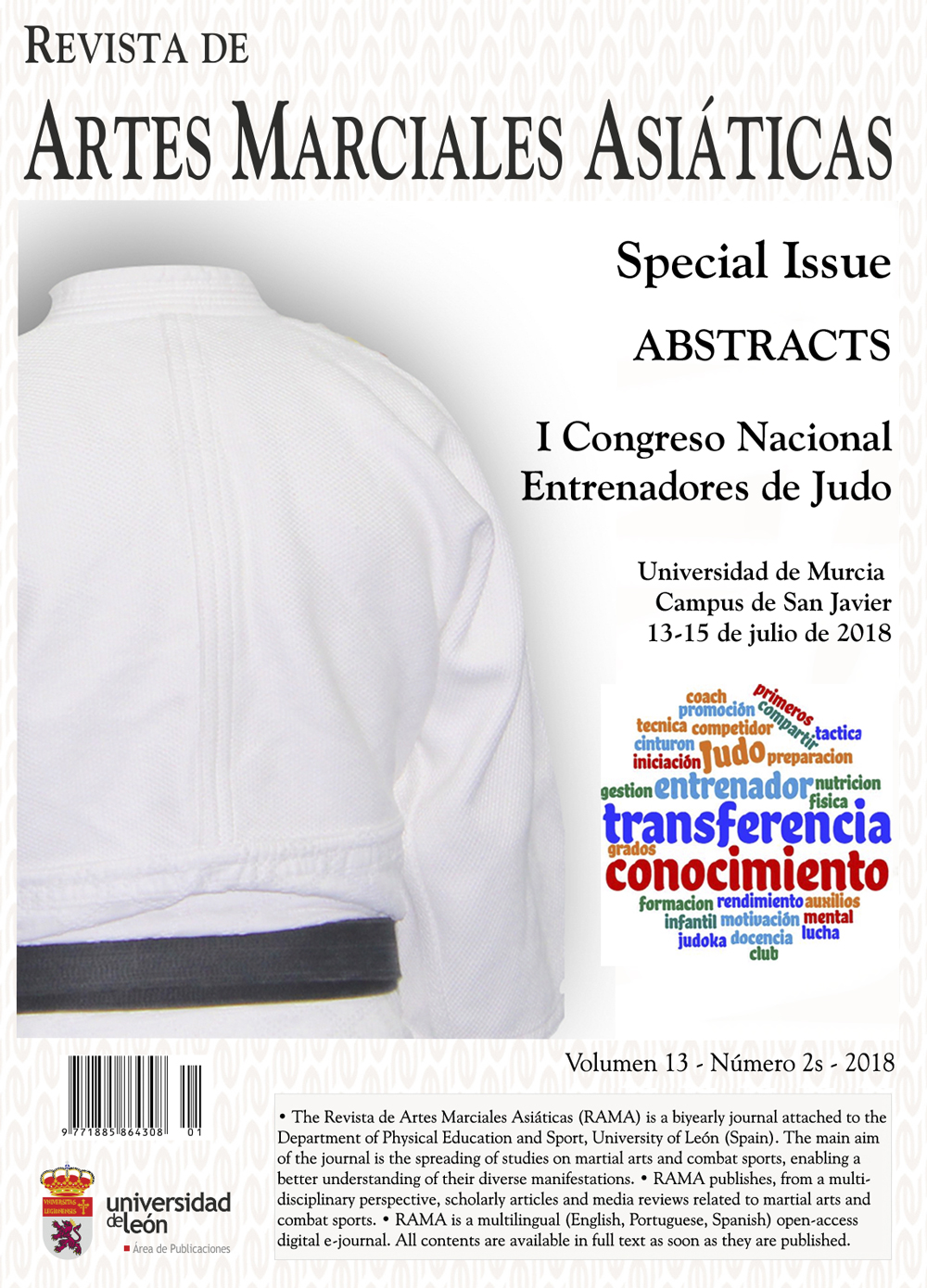Analysis of the flexibility profile in young taekwondo athletes
DOI:
https://doi.org/10.18002/rama.v13i2s.5503Keywords:
Combat sports, taekwondo, range of movement, tightness, injuryAbstract
The main aim of this study was to determine the flexibility profile of the lower extremity in young taekwondo athletes, as well as identifying athletes with muscle shortness. For this purpose, a total of 17 young taekwondo athletes were assessed; seven from the Spanish team and ten from the Murcia team. The range of motion of the main movements of the lower extremity was evaluated by the "ROM SPORT" protocol and a descriptive analysis of each of the quantitative variables was performed. A Student t-test or arWilcoxon test was applied depending on the normality distribution of the data. The ROM values of each movement were classified as “normal” or “shortness” according to previously determined reference values. The results define the following flexibility profile: 23º for iliopsoas, 28º for piriformis, 37º for gastrocnemius, 42º for soleus, 46º for adductors, 46º for external rotators, 56º for internal rotators, 77º for monoarticular adductors, 80º for hamstrings, 140º for quadriceps and 145º for gluteus maximus. Individual evaluations identified muscle shortness in pyramidal (11 athletes, 64.7%), soleus (13 athletes, 76.4%), external rotators (8 athletes, 47%), monoarticular adductors (14 athletes, 82.3%), hamstrings (13 athletes, 76.4%), quadriceps (4 athletes, 23.5%) and gluteus maximus (12 athletes, 70.5%). This flexibility profile can help sports professionals to set quantifiable goals for the training of flexibility in this sport. The inclusion of stretching exercises or the increase of their doses should be applied for the improvement of the identified shortness in piriformis, soleus, external hip rotators, monoarticular, hamstring, quadriceps and gluteus maximus adductors.
Downloads
Métricas alternativas
References
Bridge, C.A., Ferreira da Silva Santos, J., Chaabène, H., Pieter, W., & Franchini, E. (2014). Physical and physiological profiles of taekwondo athletes. Sports Medicine, 44(6), 713-33. doi: http://doi.org/10.1007/s40279-014-0159-9
Campos, F.A., Bertuzzi, R., Dourado, A.C., Santos, V.G.F., & Franchini, E. (2012). Energy demands in taekwondo athletes during combat simulation. European Journal of Applied Physiology, 112(4), 1221-1228. doi: http://doi.org/10.1007/s00421-011-2071-4
Cardozo, L. A., Vera-Rivera, D. A., Conde-Cabezas, O. A. y Yánez, C. A. (2017). Aspectos fisiológicos de deportistas elite de taekwondo: Una revisión narrativa. Revista Española de Educación Física y Deportes, (418), 35-46.
Cejudo, A. (2015). Deporte y flexibilidad: Rendimiento deportivo sin riesgo de lesión (Tesis Doctoral). Universidad de Murcia, San Javier, España.
Cejudo, A., Sainz de Baranda, P., Ayala, F. & Santonja, F. (2015). Test-retest reliability of seven common clinical tests for assessing lower extremity muscle flexibility in futsal and handball players. Physical Therapy in Sport, 16(2), 107-113. doi: http://doi.org/10.1016/j.ptsp.2014.05.004
Cejudo, A., Sainz de Baranda, P., Ayala, F. & Santonja, F. (2017). Clasificación de los valores de rango de movimiento de la extremidad inferior en jugadores de fútbol sala. SPORT TK, 6(1), 41-50.
Ellenbecker, T.S., Ellenbecker, G.A., Roetert, E.P., Silva, R.T., Keuter, G. & Sperling, F. (2007). Descriptive profile of hip rotation range of motion in elite tennis players and professional baseball pitchers. The American Journal of Sports Medicine, 35(8), 1371-1376.
Heller, J., Peric, T., Dlouha, R., Kohlíková, E., Melichna, J., & Nováková, H. (1998). Physiological profiles of male and female taekwon-do (ITF) black belts. Journal of Sports Sciences, 16(3), 243-249. doi: http://doi.org/10.1080/026404198366768
Hopkins, W., Marshall, S., Batterham, A.M. & Hanin, J. (2009). Progressive statistics for studies in sports medicine and exercise science. Medicine & Science in Sports & Exercise, 41(1), 3-12. doi: http://doi.org/10.1249/MSS.0b013e31818cb278
López-Valenciano, A., Ayala F., Vera-Garcia, F.J., De Ste Croix, M., Hernández-Sánchez, S., Ruiz-Pérez, I., Cejudo, A. & Santonja, F. (en prensa). Comprehensive profile of hip, knee and ankle ranges of motion in professional soccer players. The Journal of Sports Medicine and Physical Fitness (in press).
Markovic, G., Misigoj-Durakovic, M., & Trninic, S. (2005). Fitness profile of elite Croatian female taekwondo athletes. Collegium antropologicum, 29(1), 93-9.
Pallant, J. (2007). SPSS survival manual: a step by step guide to data analysis using SPSS. 3rd edition. Crows Nest, N.S.W.: Allen & Unwin.
Pion, J., Fransen, J., Lenoir, M., & Segers, V. (2014). The value of non-sport-specific characteristics for talent orientation in young male judo, karate and taekwondo athletes. Archives of Budo, 10, 147-150.
Rivera, M., Rivera-Brown, A., & Frontera, W. (1998). Health related physical fitness characteristics of elite Puerto Rican athletes. Journal of Strength & Conditioning Research, 12(3), 199-203.
Wasik, J. (2009). Structure of movement of a turning technique used in the event of special techniques in Taekwon-do ITF. Archives of Budo, 5, 111-115.
World Taekwondo Federation. (2017). WTF website. Recuperado de www.worldtaekwondo.org
Downloads
Published
How to Cite
Issue
Section
License
Copyright (c) 2018 Antonio Cejudo Palomo, Blanca San Cirilo Soriano, Francisco Javier Robles Palazón, María Del Pilar Saiz De Baranda

This work is licensed under a Creative Commons Attribution-NonCommercial-ShareAlike 4.0 International License.
The authors who publish in this journal must agree to the following terms:
- The authors grant on a nonexclusive basis the exploitation rights (reproduction, distribution, public communication and transformation) of the work accepted for publication to the University of León. The authors can establish, on their own, additional agreements for the non-exclusive distribution of the version of the work published in the journal (for example, placing it in an institutional repository or publishing it in a book), always acknowledging the initial publication in this journal.
- This work is licensed under the Creative Commons Attribution-NonCommercial-ShareAlike 4.0 International License. Click to see basic information and the legal text of the license.
- The authors are allowed and encouraged to disseminate electronically pre-print or post-print versions of their work before publication, as this can give rise to productive exchanges, as well as earlier and increased citing of the works published.











